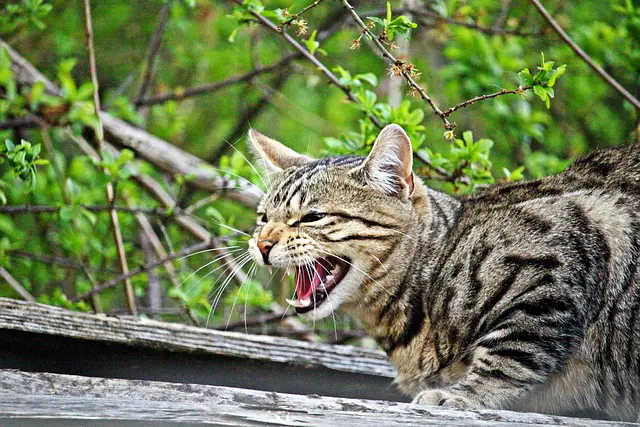One of the most frequent questions people ask about cat behavior is how to tell if a cat is angry. Reading a cat’s body language is not as obvious as you would think; people get it wrong all the time. While there are some obvious signs your cat is angry, such as hissing or running away, there are more subtle signs you can miss.
1. Tail Flicking a Swishing
Most people get this one wrong; they either ignore what a cat is doing with their tail or they think it’s a sign of excitement and happiness (like in dogs). If you see a cat aggressively flicking, swishing or cracking their tail like a whip it means they’re angry. Usually this is one of the first signs to present itself and an early way to tell if a cat is angry.
2. Arched Back and Hair Raised
Also known as the Halloween cat pose, when a cat stands with arched back and hair raised it can mean they are angry. Sometimes they’ll do this if they are playful or scared, but combined with some of the other signs in this article it means they are getting feeling irritable.
3. Ears Flat Against the Head

Another surefire way to tell if a cat is angry is if their ears are pinned back flat against their head. Usually their eyes will be large like saucers as well.
4. Agitated Meowing
Aside from regular meowing, if your cat is meowing quickly and abruptly, or making low vocal sounds, it could be a sign they are in distress and they’re trying to let you know. Cats developed certain noises only to communicate with humans (crazy, I know), and paying close attention to the sounds they make is a good way to understand how they’re feeling.
5. Hissing
Hissing is pretty commonly known as a way to tell if a cat is angry. Usually this is one of the more escalated signs of agitation, so if a cat is hissing or growling it’s a sure sign you need to leave them alone and give them space.
6. Pulling Back

If you see a cat pulling its body back with its legs out in front, it’s very likely they are angry. This position acts like a wound up spring, allowing the cat to pounce or strike quickly at a moment’s notice. It also distances their face and neck away from what they perceive as being dangerous. Usually cats will do this more if they’re trapped and can’t easily get away.
7. Purring
Most of the time a cat will purr because they’re happy and comfortable, but purring can also be a sign of distress. Cats will sometimes purr if they are angry or scared, like when they’re visiting the vet.
8. Glaring

If a cat is fixated with a narrow-eyed glare, it’s probably a sign they’re angry. Usually you can differentiate a glare from a regular stare by how intense their gaze is and how narrowed their eyes are. Sometimes they won’t necessarily glare at the thing they’re angry at, either, but off in the distance.
9. Hiding
If a cat is in distress and angry, they will often hide to get away from the thing that is causing that distress. You should never try to fish out a hiding cat; that could just make them more angry. Leave them alone and give them time to calm down.
Why is it Important to Tell if a Cat is Angry?
So why does it matter whether or not you can tell if a cat is angry? Well, for one, your own well-being or the well-being of those around you is at risk. If a cat is wound up enough they will bite, scratch or claw at you, and their teeth and nails contain bacteria that can cause infections.
It’s important to understand how your actions might be affecting your or someone else’s cat. Knowing when to leave a cat alone will safeguard their feelings of security and keep them from being conditioned to attack more often. It will also keep the cat from feeling too stressed out, which can cause a host of other issues like peeing outside the litter box or developing health issues like Feline Idiopathic Cystitis.
What Makes a Cat Angry?
Knowing what might trigger a cat to become angry can help prevent their agitation in the first place. Here are several things that can make a cat angry:
- Another animal in their territory
- Not being able to access resources such as food, water, or the litter box
- A person or pet bothering them in a way they don’t like, such as playing rough, rubbing their belly, or picking them up
- Pain or illness














